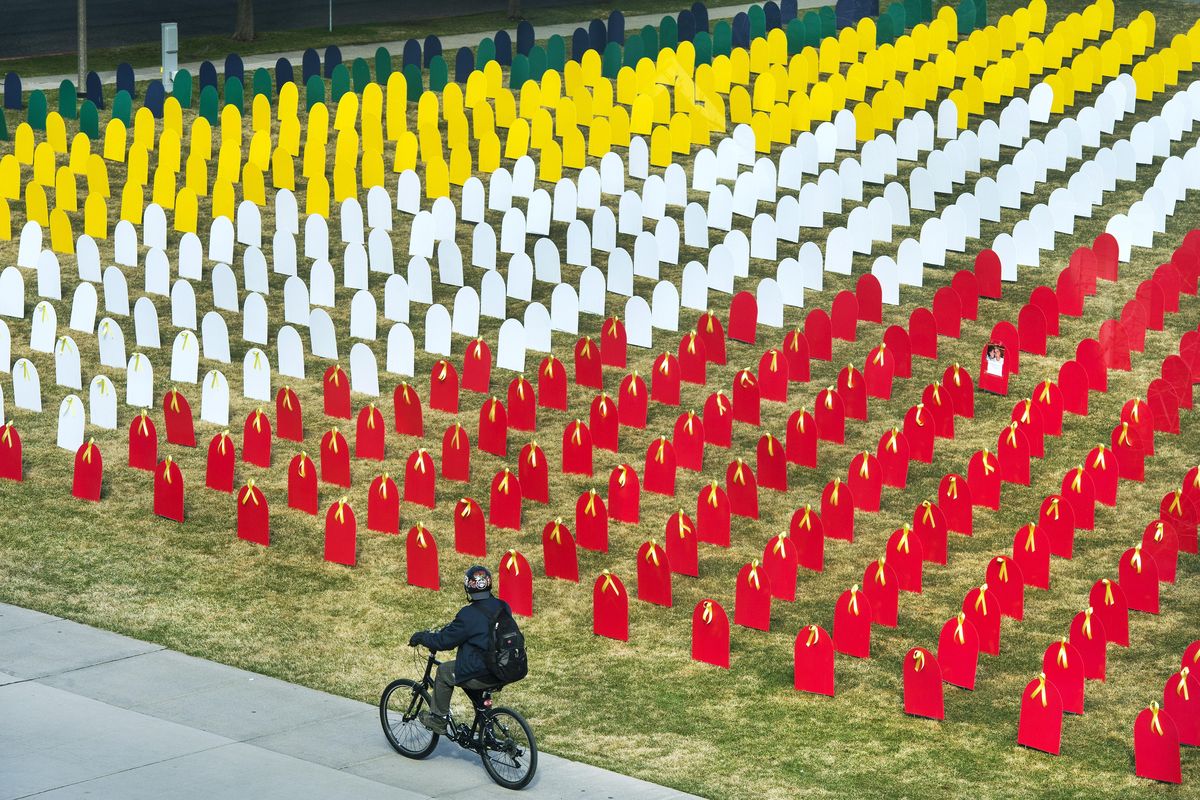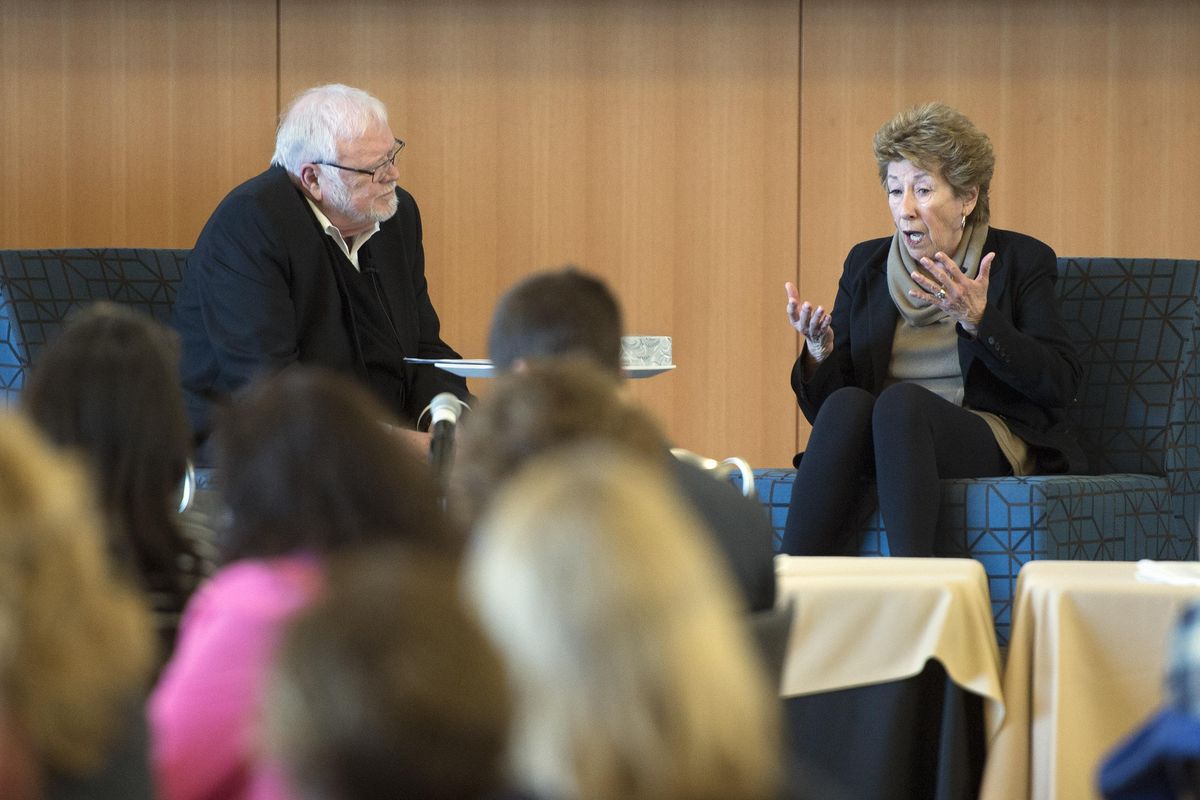Suicide conference highlights Washington bill creating awareness training for gun dealers
The Suicide Safer Homes Memorial attracts the attention of a passing cyclist on the Gonzaga University campus at 720 E. Desmet, March 11, 2016, in Spokane, Wash. The installation of 1,111 tombstones remembers the lives lost to suicide in Washington State in 2014, including 233 veterans. The red markers indicate death by firearms (544), White represents suffocation (258), yellow is for poisoning (207), green is for jump and cut (57) and blue indicates other means (45). The yellow ribbons on the markers honor the veterans lost to suicide. (Dan Pelle / The Spokesman-Review)Buy a print of this photo
In Washington state, nearly 80 percent of gun deaths are suicides.
After losing her husband to suicide in 2011, Jenn Stuber started wondering how that statistic could be changed. Her husband, a 40-year-old attorney battling anxiety and depression, had shot himself with a gun he’d recently purchased.
Stuber, a University of Washington social work professor, made a cold call to the National Rifle Association. It was the beginning of an alliance between suicide prevention groups and gun advocates. They worked together to craft Washington’s Suicide Awareness and Prevention Education for Safer Homes Act.
The bill develops suicide prevention training for gun dealers and owners of shooting ranges. It would add suicide prevention messages to hunter safety courses, promote education about safe firearm storage, and also uses pharmacists to talk to customers about safe storage of prescription drugs.
“We may not agree on gun control, but we all want to prevent suicide,” said Stuber, one of the speakers at the Zero Suicide Inland Northwest conference Friday at Gonzaga University. “One bullet fired, and I became a single parent and a widow.”
The Zero Suicide conference brought together about 500 health care professionals, law enforcement officers, people who have lost family members to suicide and others to talk about prevention.
Washington, Idaho and Montana have suicide rates that are higher than the national average. The reasons behind the high rates are complex, said Karl Rosston, Montana’s suicide prevention coordinator. Isolation in rural communities, weather, poverty, alcoholism rates and lack of access to mental health care providers are contributing factors.
Access to guns is also part of the equation. In the three states, more than half of suicides involve guns, and the majority of youth suicides involve a family-owned firearm. Last year, an 11-year-old Montana boy shot and killed himself while his parents were in the midst of a nasty custody battle. He was the state’s youngest suicide victim.
Military veterans and law enforcement officers also have high rates of suicides involving firearms.
But securing guns when a family member is at risk can still be a difficult conversation, Rosston said. When he met with the parents of two suicidal teens in Livingston, Montana, they were reluctant to lock their guns away.
In Washington, the legislation uses the trusted relationship that people have with their gun dealer or pharmacist to help drive home suicide prevention messages, Stuber said. Suicide awareness training would be required for pharmacists and voluntary for firearms dealers.
“Firearms dealers often have close relationships with their customers,” she said. “They’re the new messengers in our state.”
The bill has the support of the NRA and the Second Amendment Foundation, whose co-founder Alan Gottlieb testified in favor of it last month. The legislation passed both houses with bipartisan support and is under consideration in Washington’s budget negotiation process. If it becomes law, the legislation would cost the state about $300,000 to implement next year, Stuber said.
Stuber is the co-founder of Forefront, a Washington suicide prevention organization. She was also part of efforts to require mental health professionals and other care providers to receive suicide assessment training. The Matt Adler Law, enacted in 2012, was named after her husband.
At Friday’s conference, health care professionals shared stories about working with suicidal patients and recognizing suicidal behavior.
Last week, a young woman walked into the Panhandle Health District office in Hayden. She’d taken a dozen Benadryl pills. While talking with a nurse, she acknowledged that she’d been taking pills for several days in an effort to end her life.
“We are challenged in every direction to confront a scourge that is taking the lives of people we love and the people we are responsible for as care providers,” said Dr. John Osborn, a Department of Veterans Affairs physician, who lost a nephew to suicide two years ago.
Even though mental health issues and suicide are discussed more openly now, there are still societal stigmas that hinder diagnosis and treatment, health care providers said. That’s why suicide prevention has to become a communitywide effort, they said.
“In my view, the last taboo is suicide,” said Paul Quinnett, found of the QPR Institute for Suicide Prevention in Spokane.
This story was updated to reflect that participation in suicide awareness training would be voluntary for gun dealers under the proposed legislation.

